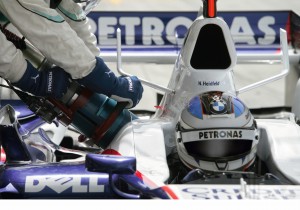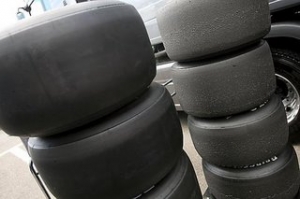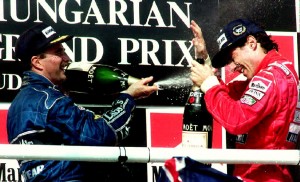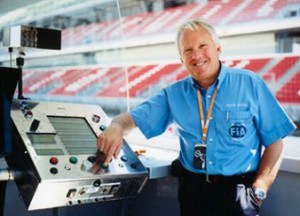 In a meeting on Tuesday, the Formula One Teams’ Association (FOTA) continued discussions on how to reduce costs in F1. One of the ideas proposed was the scrapping of refueling.
In a meeting on Tuesday, the Formula One Teams’ Association (FOTA) continued discussions on how to reduce costs in F1. One of the ideas proposed was the scrapping of refueling.
the FIA wants the cost of competing in Formula One to fall to less than 100m for manufacturer backed teams and 50m for the independent teams. Last year Toyota spent over 300m on their F1 team.
FOTA have already agreed that manufacturers will supply cheap engines to independent teams in 2010 but in a white paper seen by the Financial Times the FIA want to define a limited number of areas where teams can compete in development. Areas such as engine, gearbox and suspension would be designated as “non-compete”. In the article , Ron Dennis sounds a warning about increasing standardisation:
F1 should not be a prescriptive formula where engines and a large group of components should be standard. That places total emphasis on the driver, and if you went down that route the drivers would be the [important] ingredient and that is where the money would be spent.
I couldn’t agree more. It might sound appealing at first to have nearly identical cars with the only variable being the driver but this isn’t what Formula One is about. Yes, costs should be reduced where possible to allow independent teams to take part, but if F1 moves towards becoming another spec-series it would lose its special appeal. Furthermore, as Ron says, if the only thing teams could spend money on was the driver then they would just shift large portions of their budgets from car development to driver salaries.
As far as banning refueling goes I’m not so sure. It was introduced in 1994 and I do think it adds to the show. It also encourages different race strategies. I’m not sure how banning it would reduce costs as all teams use a standard refueling rig anyway. The only real argument for banning it would be on safety grounds but surely the Grand Prix Drivers’ Association would have raised this if safety was an issue?
 According to La Gazzetta dello Sport, Formula One circuit designer, Hermann Tilke is in Rome analysing possible layouts for a Roman street circuit. The idea of Rome hosting a Grand Prix as early as 2011 was raised by former Formula Two driver, Maurizio Flammini last week. Italy already hosts a Formula One Grand Prix at the historic Monza circuit.
According to La Gazzetta dello Sport, Formula One circuit designer, Hermann Tilke is in Rome analysing possible layouts for a Roman street circuit. The idea of Rome hosting a Grand Prix as early as 2011 was raised by former Formula Two driver, Maurizio Flammini last week. Italy already hosts a Formula One Grand Prix at the historic Monza circuit.
While the idea of F1 cars racing through the streets of Rome has a certain appeal, the Italian paper reports that three locations are being investigated all of which are in the Esposizione Universale Roma (EUR) business district south-west of the historic city centre. According to Wikipedia, “EUR offers a large-scale image of how urban Italy might have looked, if the Fascist regime had not fallen; wide axially planned streets and austere buildings.”
Ferrari Boss Luca di Montezemolo, no fan of street circuits himself, doesn’t like the idea of a Roman Grand Prix:
A new grand prix in Italy is absolutely unthinkable, given that we have so many underused circuits.
Now, I quite like the Fascist architectural style but if you were hoping to see Ferraris screaming around the Fontana di Trevi and past the Spanish Steps the reality, if it ever happens, will be quite different.
Image: lazymood
 In 2006 the FIA decided to select a single tyre manufacturer that would supply all Formula One teams from 2008. Previously, there had been two tyre manufacturers in F1; Michelin and Bridgestone, but after Michelin ruled itself out of the bidding process the contract was awarded to Bridgestone.
In 2006 the FIA decided to select a single tyre manufacturer that would supply all Formula One teams from 2008. Previously, there had been two tyre manufacturers in F1; Michelin and Bridgestone, but after Michelin ruled itself out of the bidding process the contract was awarded to Bridgestone.
Without the variance of different tyre manufacturers the FIA introduced a rule in an attempt to encourage overtaking whereby in every race each driver must use both compounds chosen by Bridgestone. Now FIA Race Director, Charlie Whiting, says the difference in compounds isn’t great enough:
This year, once again, each driver will have to use two different types of slick tyres during the race. We wanted to have a bigger difference between them. Sometimes, in 2008, this gap was a matter of one or two tenths. We thought it would be better if it was bigger. The Bridgestone engineers are working on that. Sometimes, in 2008, the difference between the two types of tyres was negligible wasnt it? One couldnt see the difference between the two, really.
In a 2005 interview, Michelin’s Competitions Director Pierre Dupasquier explained why he thought the tyre monopoly was a bad idea:
As we see it, the major inconvenience is twofold; You reduce the technological showcase that is F1 to the level of a single-make formula and you would lose the interest of making new discoveries and innovating in a competitive environment.
I’ve got an idea. Instead of coming up with contrived rules so that drivers will always be on the ‘wrong’ tyre at some point in the race, why not open Formula One up to all tyre manufacturers. This would encourage competition and development and would also provide the difference in tyre performance that is enforced artificially now.
 Bernie Ecclestone’s medal system – whereby gold, silver and bronze medals would be awarded to the top three drivers at each race, with the driver with the most golds at the end of the year being crowned champion – has come in for a lot of criticism from drivers as well as fans. I thought it would be interesting to take Bernie’s idea and look back to see how many times a world champion had won fewer races than his rivals.
Bernie Ecclestone’s medal system – whereby gold, silver and bronze medals would be awarded to the top three drivers at each race, with the driver with the most golds at the end of the year being crowned champion – has come in for a lot of criticism from drivers as well as fans. I thought it would be interesting to take Bernie’s idea and look back to see how many times a world champion had won fewer races than his rivals.
In a blog post last week I analysed every year of the FIA F1 World Drivers’ Championship and found that drivers have been winning the Championship with fewer wins than their competitors at a pretty consistent rate since the Championship began. In fact in very first season, in 1950, it was won by Nino Farina even though Fangio won the same number of races.
Now it seems the FIA has had the same idea and come up with broadly the same results. Do they read my blog or have they been working on this research for some time? To be fair, the FIA have applied the full Bernie treatment to the results, taking account of silver and bronze medals, whereas I just looked at the number of wins but my little post certainly didn’t trigger the same amount of discussion.
All across the tubes fans are arguing about medals vs the current points system, the old points system vs the current points system and even coming up with new and improved points systems that include bonus points for fastest laps. BlogF1 asks where the market research is. Seems like the FIA just needs to read the comments.
Image: GAUTREAU-KSIAZEK/AFP/Getty Images
 In a technical briefing published on the FIA website, FIA Formula One Race Director,Charlie Whiting, has clarified the new engine rules for 2009.
In a technical briefing published on the FIA website, FIA Formula One Race Director,Charlie Whiting, has clarified the new engine rules for 2009.
There has been some confusion over the new regulations as previously “Each driver may use no more than one engine for two consecutive Events in which his team competes.”, but the new rules specify only a limit of eight engines to be used during the entire season and mention nothing about consective races.
In the briefing Whiting says:
Its eight engines for the whole year. A driver will only incur a penalty if he uses a ninth engine. So the teams can use the engines as they like. Theres no three consecutive race rule because there doesnt seem to be a need for it any longer. The engines will not have to do three complete events now.
In the past, as you know, the two-race engine was used only on Saturdays and Sundays. Now, for 17 races, the eight engines will have to do the three days of each grand prix. What the teams will do is to have a Friday engine thatll probably do the first four races or something of that nature. Theyll then take the engine out and use another one for Saturday and Sunday. All weve got to do, – itll be extra work – is to make sure that these engines remain sealed and are untouched.
So teams will be able to change engines whenever they wish, including during an event. What still isn’t clear is if a driver uses a ninth engine will he be penalised for the rest of the season or only at the next race?
 In a meeting on Tuesday, the Formula One Teams’ Association (FOTA) continued discussions on how to reduce costs in F1. One of the ideas proposed was the scrapping of refueling.
In a meeting on Tuesday, the Formula One Teams’ Association (FOTA) continued discussions on how to reduce costs in F1. One of the ideas proposed was the scrapping of refueling. According to La Gazzetta dello Sport, Formula One circuit designer, Hermann Tilke is in Rome analysing possible layouts for a Roman street circuit. The idea of Rome hosting a Grand Prix as early as 2011 was raised by former Formula Two driver, Maurizio Flammini last week. Italy already hosts a Formula One Grand Prix at the historic Monza circuit.
According to La Gazzetta dello Sport, Formula One circuit designer, Hermann Tilke is in Rome analysing possible layouts for a Roman street circuit. The idea of Rome hosting a Grand Prix as early as 2011 was raised by former Formula Two driver, Maurizio Flammini last week. Italy already hosts a Formula One Grand Prix at the historic Monza circuit. In 2006 the FIA decided to select a single tyre manufacturer that would supply all Formula One teams from 2008. Previously, there had been two tyre manufacturers in F1; Michelin and Bridgestone, but after Michelin ruled itself out of the bidding process the contract was awarded to Bridgestone.
In 2006 the FIA decided to select a single tyre manufacturer that would supply all Formula One teams from 2008. Previously, there had been two tyre manufacturers in F1; Michelin and Bridgestone, but after Michelin ruled itself out of the bidding process the contract was awarded to Bridgestone.
